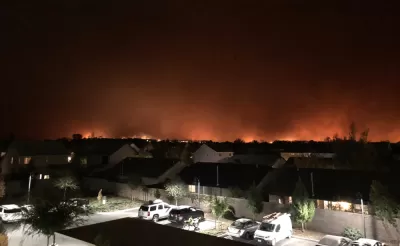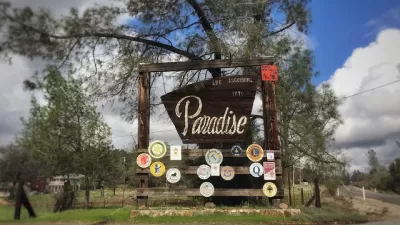A proposed development near the site of the devastating Camp Fire highlights the growing tension between building badly needed housing and protecting communities from heightened wildfire risk.

The conflict between California’s dire housing shortage and the state’s growing wildfire risk is at the heart of a debate over a new development in the Central California town of Chico, where a proposed community would build 3,000 homes and commercial buildings in a fire-prone area just outside of town. The two-year battle over approving the development will be decided by the city council, according to an article by Jake Bittle for Grist and republished in Next City.
Bill Brouhard, the developer of the project, called Valley’s Edge, says the community is designed to be protected from fire and would itself act as a fire break for the rest of the city “thanks to ample parks and trails outfitted with fire-resistant vegetation and pavement.” Brouhard claims the development would actually reduce Chico’s fire risk rather than increase it. “The development will be built in compliance with the latest California fire construction regulations and will be an accredited member of the Firewise program, a nationwide initiative designed to promote fire-safe building practices.”
However, conservationists and other critics say those measures aren’t enough to prevent catastrophe, and that cities should refuse building permits in areas with such high fire danger.
The project illustrates a Catch-22 for the city that is becoming all too common across California and the West. “If Brouhard’s opponents are right, the developer’s pet project could someday become another Paradise. If the project isn’t built, however, the housing crisis in Chico may only get more painful.”
FULL STORY: This California City Needs Housing. But Is A New Development Destined To Burn?

Study: Maui’s Plan to Convert Vacation Rentals to Long-Term Housing Could Cause Nearly $1 Billion Economic Loss
The plan would reduce visitor accommodation by 25,% resulting in 1,900 jobs lost.

North Texas Transit Leaders Tout Benefits of TOD for Growing Region
At a summit focused on transit-oriented development, policymakers discussed how North Texas’ expanded light rail system can serve as a tool for economic growth.

Why Should We Subsidize Public Transportation?
Many public transit agencies face financial stress due to rising costs, declining fare revenue, and declining subsidies. Transit advocates must provide a strong business case for increasing public transit funding.

How to Make US Trains Faster
Changes to boarding platforms and a switch to electric trains could improve U.S. passenger rail service without the added cost of high-speed rail.

Columbia’s Revitalized ‘Loop’ Is a Hub for Local Entrepreneurs
A focus on small businesses is helping a commercial corridor in Columbia, Missouri thrive.

Invasive Insect Threatens Minnesota’s Ash Forests
The Emerald Ash Borer is a rapidly spreading invasive pest threatening Minnesota’s ash trees, and homeowners are encouraged to plant diverse replacement species, avoid moving ash firewood, and monitor for signs of infestation.
Urban Design for Planners 1: Software Tools
This six-course series explores essential urban design concepts using open source software and equips planners with the tools they need to participate fully in the urban design process.
Planning for Universal Design
Learn the tools for implementing Universal Design in planning regulations.
City of Santa Clarita
Ascent Environmental
Institute for Housing and Urban Development Studies (IHS)
City of Grandview
Harvard GSD Executive Education
Toledo-Lucas County Plan Commissions
Salt Lake City
NYU Wagner Graduate School of Public Service




























